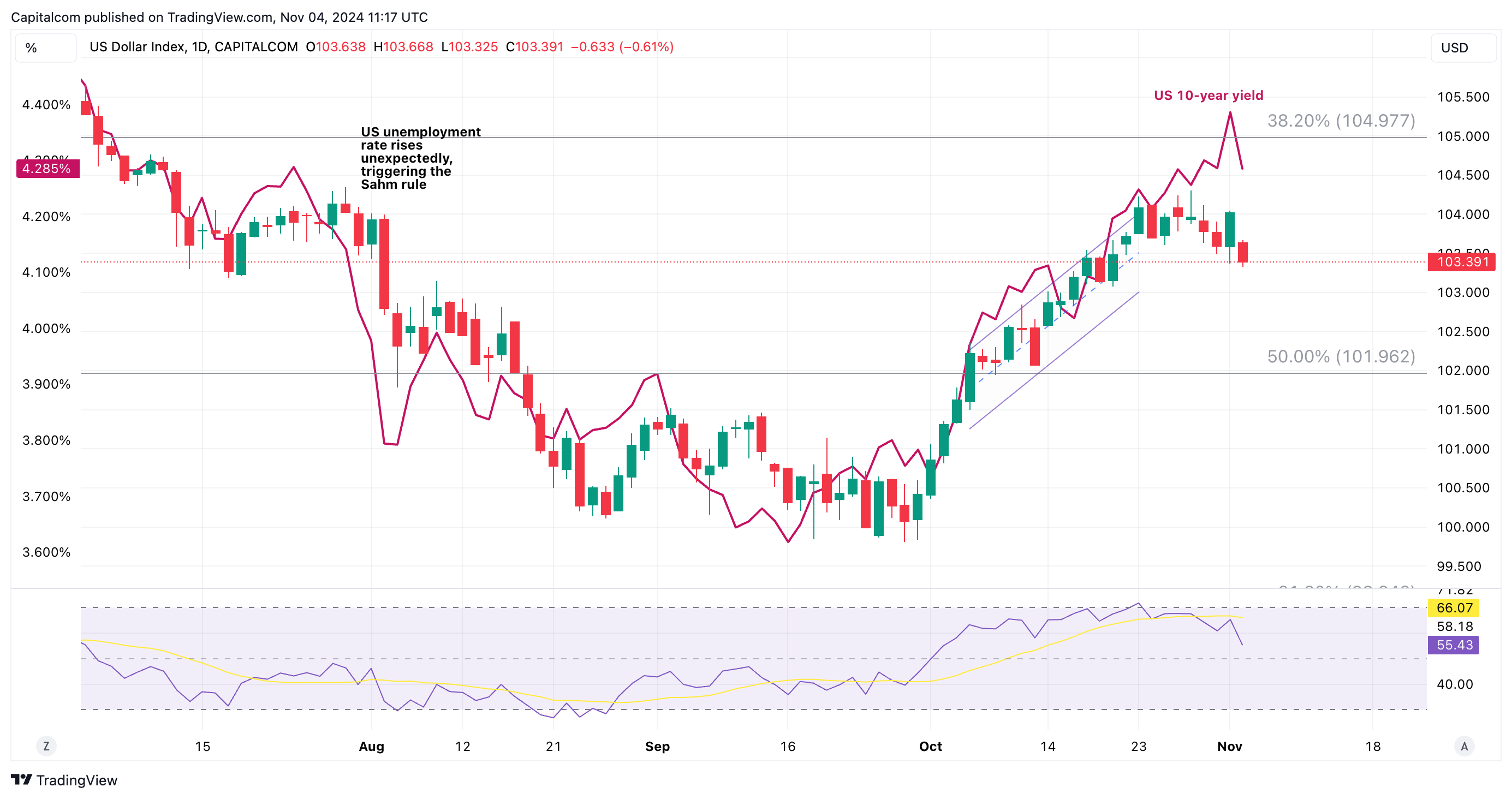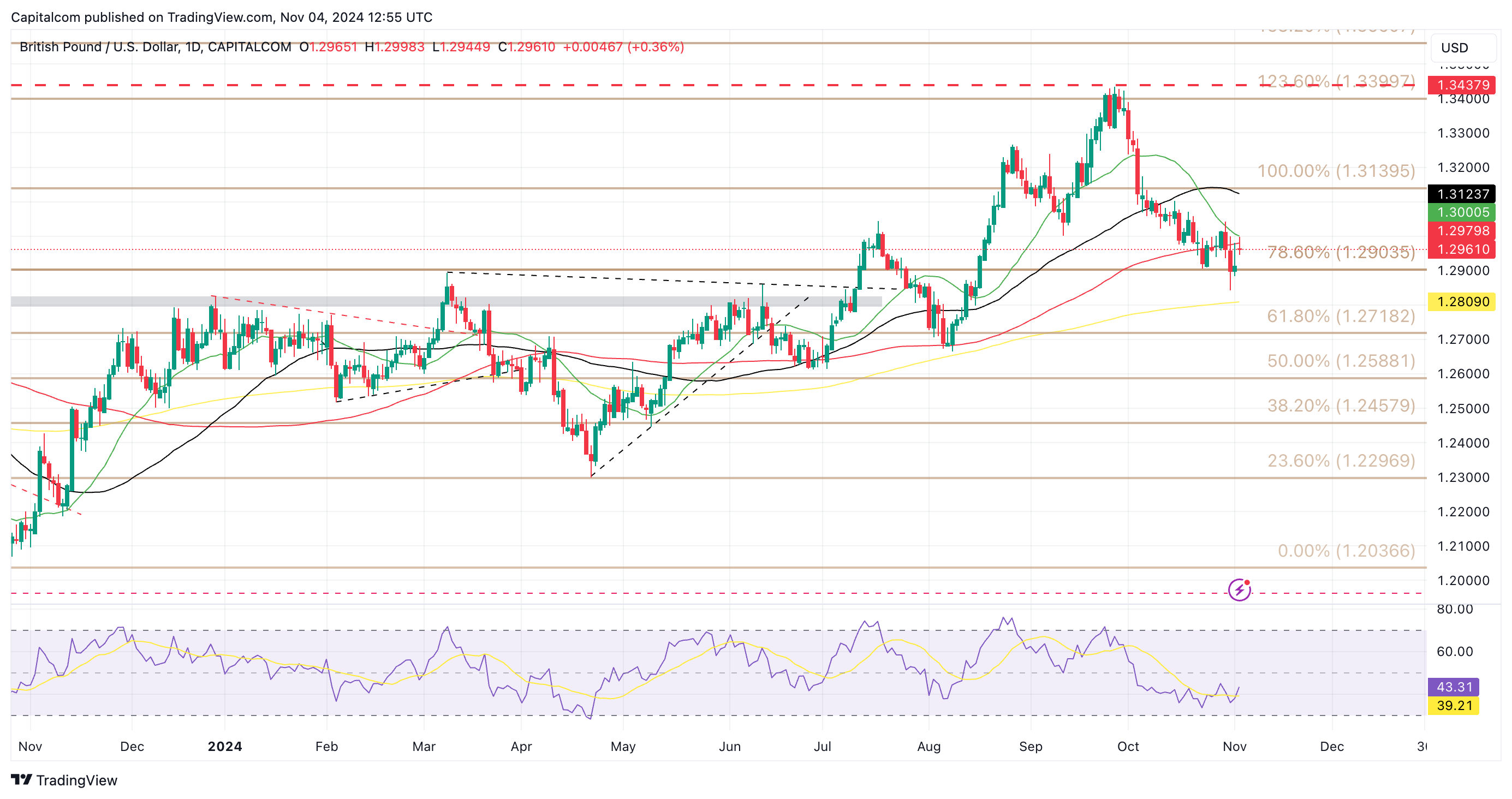FOMC and BOE preview: further rate cuts expected
Both the Federal Reserve and the Bank of England are expected to cut rates further when they meet later this week.
The US presidential election will be the key focus this week with prediction markets reversing some of the Trump trade, suggesting a very tight race. Meanwhile, both the Federal Reserve and Bank of England are set to announce their latest monetary policy updates on Thursday, with a 25 basis point cut expected from each.
Federal Reserve to cut regardless of election outcome
Money markets are assigning a 98.5% chance that the Federal Reserve will cut rates by 25bps on Thursday. The odds have increased this week after disappointing jobs data was released on Friday. Given how expectations had been set pretty low at just 100,000 new jobs added in October, the consensus heading into the data release is that there would likely be a big beat on the upside. But in fact, the data came in much lower than predicted on Friday, with just 12,000 new jobs added. Moreover, manufacturing payrolls dropped the most since the height of the pandemic in 2020, with a drop of 56,000, much more than the 26,000 expected.
Interestingly, bond markets continued to sell off, with the 10-year yield rising another 2% on Friday. The market seems to have stabilised at the start of the new week, but traders seem unfazed by the weak employment data, likely a result of broader market dynamics and a focus on wages data, which continues to remain strong even amid lower payroll numbers.
The weaker NFP data seems to have solidified expectations of a rate cut from the Federal Reserve, despite recent speculation that strong economic data, and the Trump trade pushing USD and yields higher, might lead to a delay. The central bank is expected to cut rates regardless of the outcome of the election, a fair assumption given how close in time the two events are. If the outcome of the election is perceived to impact inflation and growth, the Federal Reserve will have to adjust its monetary policy accordingly, but any such response will come later. For now, the Fed wants to adjust the real fed funds rate gradually lower as part of a recalibration rather than a full easing cycle. It is important to remember that examples of a central bank lowering rates without a recession are rare, making it harder to predict how the cycle may evolve.
The Fed is likely to prioritise a weakening jobs market over an uptick in inflation. Despite the 50-bps cut in September, the policy rate remains in restrictive territory, allowing room for another cut without too much concern about an inflationary rebound. That said, Jerome Powell will likely be cautious with his language, especially given potential market volatility following the result of the election.
The US dollar has been a key focus area in recent weeks as the Trump trade and stronger economic data has pushed it to three-month highs, reversing the weakness seen after the Sahm rule trigger in August. Were it not for the election, short-dated treasuries dropping on the expectation of two more rate cuts in 2024 could be seen as negative for the dollar, but FX volatility this week is expected to stem primarily from the result of the election.
Meanwhile, US treasuries are unlikely to see any meaningful reaction if the Fed cuts rates by 25 points as expected. With Biden’s term continuing until January, economic data will likely remain the primary driver of Fed policy for December, suggesting another 25 basis point cut is likely. The 10-year yield could continue to rise until clearer evidence of an economic slowdown emerges. So far, the weaker jobs growth – which was impacted by weather and strikes – was not enough to convince bond markets.
US dollar index (DXY) and US 10-year Treasury yield daily chart
 Past performance is not a reliable indicator of future results.
Past performance is not a reliable indicator of future results.
BOE to cut again, but forward guidance is uncertain
Just hours before the Federal Reserve, the Bank of England is also expected to cut interest rates by 25 basis points. Current pricing suggests a 91% probability of this cut despite a shallower path of interest rates expected following Rachel Reeves’ budget unveiled last week. The central bank is likely to remain focused on its long-term goal of lowering inflation and balancing growth and is therefore expected to continue gradually cutting rates.
The latest consumer price index (CPI) reading showed inflation dropping to 1.7% in September, below the BOE’s 2% target for the first time in three years. This shows significant progress in the battle against inflation, and likely ensures a rate cut this week, though the outlook for further cuts is uncertain. Chancellor Reeves’ budget is expected to increase inflationary pressures in the coming years, suggesting the BOE may have to keep rates higher in the long run.
Since the Budget release, the rate curve has flattened and the BOE is now expected to cut rates less aggressively than the Fed and the ECB. While the Fed and ECB are expected to cut rates by 115 basis points by September 2025, the BOE is only expected to cut 90 basis points in that same timeframe.
This less dovish stance could support the pound as rate differentials continue to play a role in FX markets. However, current volatility surrounding the US presidential election has limited GBP/USD gains, with the pair down 4% over the past five weeks. A potential bullish reversal could occur if dollar volatility dies down, and the Fed appears more likely to cut again in December compared to the Bank of England.
The Monetary Policy Committee (MPC) is also expected to release its updated forecasts on Thursday, offering an insight into how the central bank expects Labour’s tax and spending plans to impact short-term inflation and growth.
GBP/USD daily chart
 Past performance is not a reliable indicator of future results.
Past performance is not a reliable indicator of future results.